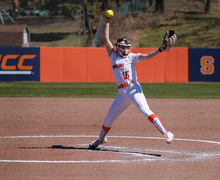When Syracuse lacrosse lost its fall seasons due to mumps, players were left in isolation
Sarah Allam | Head Illustrator
On Oct. 6, Syracuse cancelled all fall season events for Men's and Women's lacrosse. Players were forced to figure out what to do next.
The excited screams could be heard from inside the tunnel. From the moment the Orange women’s players stepped on the field, they couldn’t erase the smiles on their faces. They screamed so loudly their voices cracked, and players skipped with every stride.
When the buzzer sounded, signaling the start of the game, SU experienced the growing pains it didn’t have a chance to deal with already. The struggles weren’t a sign of the future, but rather a reminder of the past.
Going to the locker room at halftime having already allowed eight goals, SU head coach Gary Gait addressed his team and told them the next time they stepped on the field would be different.
“That was fall ball,” Gait said of the Orange’s first half, “I hope you enjoyed it.”
Last fall, due to an outbreak of the mumps that affected more than 100 people on Syracuse University’s campus, including members of the varsity men’s and women’s lacrosse teams, SU suspended the teams’ fall seasons. During the suspension, players were barred from athletic facilities and, without the opportunity to meet up and practice with their teams, spent most of their newfound free time by themselves.
An SU spokesperson said in an email that the decision to suspend the fall season was “isolated,” adding that only the lacrosse teams were considered in the decision-making process since they were the only teams with confirmed mumps cases.
The suspension of the seasons was met with confusion by some involved in the Syracuse lacrosse programs, with players and coaches forced to figure out how to cope with the lost time.
“It was kind of just crazy, we were getting into it and we were having a good time,” said Morgan Widner, a sophomore draw control specialist on the women’s team, “(then), mumps hit.”
The situation unfolded in early October. Several men’s and women’s players said the formal announcement of the suspension occurred at meetings with their respective teams. SU defender Tyson Bomberry said members of the men’s team received texts about the situation. Asa Goldstock, the starting goalkeeper on the women’s team, said SU Athletics compliance sent mass emails to the women’s team informing them of the suspension.
On Oct. 6, Syracuse Athletics issued an official notice that all lacrosse events for the remainder of the fall season were canceled. At that time, there were eight confirmed mumps cases at SU, including members of both teams.
After the fall seasons were canceled, players were held out of SU Athletics facilities, including Manley Field House and Ensley Athletic Center, among others. With no available facilities, there was no practice, no formal team meetings. Nowhere to develop on the field.
Players on both teams said the teams were absent from the facilities for nearly the whole season. The women were restricted from early October to early December, and the men were restricted from early October to mid-November. The university, citing students’ privacy, declined to comment on the identity and number of people on the lacrosse teams with the mumps.
The isolation effect spreading beyond those who were officially diagnosed. On Oct. 7, one day after the university announced the cancellation of team events, Widner posted a photo to her Instagram account of herself Photoshopped in front of the Sheraton. The photo was captioned, “Hi MTV and welcome to my crib.”
In a text message to The Daily Orange, Jill Widner, Morgan’s mother, said Widner was quarantined in the Sheraton with an unknown illness while SU waited on test results. The tests revealed Widner had the flu, not the mumps.
“I think everyone was so worried about containing the mumps that quite a few kids were quarantined as they waited for results,” Jill said.
A university spokesperson said in an email that any student who presented “any possible symptoms of mumps” was immediately isolated “out of an abundance of caution.”

Kevin Camelo | Digital Design Editor
The outbreak caused teammates to separate for much of the time off. To stay in shape and ready for the upcoming spring season, the players had to improvise.
Freshman Sam Swart, a midfielder on the women’s team, said she got a membership to Planet Fitness and worked out routinely with fellow freshman Hannah Van Middelem. Junior goalkeeper Bri Stahrr ran a lot. Bomberry, who hasn’t had an offseason in as long as he could remember because of playing box lacrosse in the summer, took advantage of the break.
“I was just focusing to get better physically,” Bomberry said, “and trying to get faster and stronger and actually do things that people can do in an offseason.”
Stahrr said if it were up to her, she’d have spent time with her teammates, but she resigned to doing things almost exclusively on her own. Stahrr declined to comment on whether the team was told to stay separate during the suspension. The most common response about the difficulty of the stretch was that players couldn’t spend time with their teammates as much as they would’ve liked.
The women’s team took it upon themselves and reached an agreement, collectively deciding they “don’t want this spreading,” sophomore attack Emily Hawryschuk said. By keeping players away from the facilities, Hawryschuk agreed, SU was trying to prevent players from having one specific area where they could all meet and spread the mumps further.
An SU spokesperson did not directly say whether players on each team were instructed to stay apart from each other during the suspension to limit spread of the mumps.
“We were in constant communication with our entire campus community,” a university spokesperson said in an email, “including our student-athletes, to educate them on how to detect and treat mumps and how to prevent the spread of the disease. This included enforcing our aggressive response protocol, which included placing infected students in isolation and sanitizing areas that infected students may have come into contact with.”
In addition to practice, SU lost out on scheduled scrimmages. The men’s team was stripped of all its fall games, and the women’s team missed three tournaments, which tend to be three games each, Goldstock said. Already without practice time, losing fall games made it difficult for players to focus on their development. The ways they could improve their skills also remained unclear.
Goldstock played wall ball, an individual drill in which a player repeatedly throws a ball off a wall back to themselves. But, Nicole Foringer, her friend and a Boston University lacrosse player, said Goldstock claimed she was basically a “non-athlete” during the time SU was absent from the facilities.
Though both teams suffered a considerable loss to practice time, the men’s team, for reasons players said they weren’t aware of, were allowed back into facilities a week before Thanksgiving break. Men’s lacrosse head coach John Desko said the team made up most of the practices it previously thought were lost later in the fall.
Sophomore goalkeeper Drake Porter said the team was allowed to practice for about five days before Thanksgiving break and roughly two weeks between Thanksgiving and winter breaks.
The women’s team lost the entirety of its remaining fall practices. Goldstock said a small portion of the team met for “captain’s practices” in December, when they were granted access into facilities again. But the coaches weren’t present for the practices, she said.
“We had about a week at the end of the fall when we were together and we regrouped again,” Hawryschuk said. “Then we went on winter break.”
According to NCAA bylaw 17.14.2, which was revised in April 2017, women’s lacrosse teams are not permitted to start practicing until the third Saturday of January. Syracuse requested a waiver from the NCAA to start practice early to make up the time it lost.
“I just asked my compliance office if we could get any of our time back,” Gait said. “… And they did it.”
The women’s team started practice “two weeks early,” an NCAA spokesperson said in an email. The men’s team, under slightly different rules, didn’t receive a waiver.
“NCAA staff frequently work with schools to provide flexibility to NCAA rules in cases that impact student-athlete wellbeing, and this case is a good example of that cooperation,” the spokesperson said.

Kevin Camelo | Digital Design Editor
Liz Robertshaw, Boston University women’s lacrosse head coach, said she was “not a fan” of the NCAA’s decision to permit a waiver for SU to start the season early. A scheduled SU-BU matchup in the fall was canceled due to the suspension. She said since the rule is so new, the NCAA should’ve stood its ground in enforcing it.
To make up for lost time, the Orange women traveled to Florida on Jan. 6 for a week-long camp, marking the first time the Orange officially practiced since the fall season was called off on Oct. 6.
In Florida, Stahrr said, the team had two- to three-hour practices. SU players spoke glowingly of the sessions. Junior Natalie Wallon said she recognized growth from the team, adding that the Orange has “some of the best on-field chemistry” she’s seen in a while.
The men’s team had a similar experience. In its first weeks back at practice, the Orange participated in numerous intrasquad scrimmages. The competition was “electric,” Porter said, adding that the scrimmages were some of the most intense he’d experienced in his two years at SU.
While much of the early dialogue following the cancellations paralleled “what do we do?”, Widner said, Porter preferred to use the phrase “what’s next?”
Months after the cancellations, Gait sat at the podium following SU’s season opener, wearing a stone face. It was the Orange’s first game action since late September, and most players had the day marked on their calendars since the fall was cut short.
For two months, players and coaches were prevented from coming together as they always had. They missed it. Now, they were back. Gait didn’t waste any time to savor the moment.
“Wow,” he said, pausing to exhale. “It’s great to be back playing lacrosse.”
With the events of the fall behind them, back in the locker room before his team took the field for the second half, Gait offered them one more piece of motivation.
To that point, the game hadn’t been pretty. The Orange had a one-goal lead after faltering several times. He challenged his players to go on the field in the next frame with a different mindset.
Before leaving the locker room, Gait sent his team out with one final instruction: “Now let’s go play the 2018 season.”
Published on February 13, 2018 at 11:14 pm
Contact Michael: mmcclear@syr.edu | @MikeJMcCleary




